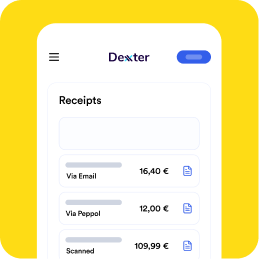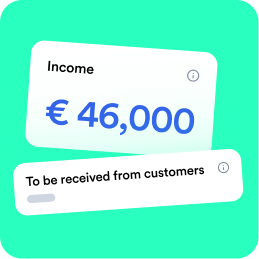Let us use an example to explain the concept of inventory in the context of your accounting.
Martien has just started his self-employed activities and bought €1,000 worth of trade goods during the year. Important, we are talking about trade goods here! You can easily find these in Dexxter if you click on reports -> income statement.
Your inventory: trade goods 📦
So only trade goods end up in your inventory, trade goods are goods you have purchased in order to sell them to customers later, some examples:
- The products you have specifically purchased to resell (after processing)
- Packaging material for your goods
- Transport material for your trade goods: boxes, envelopes …
- Ingredients, raw materials … Everything you need to make your trade goods
- …
Back to our example, where Martien bought €1,000 worth of trade goods during the year. At the end of that year, Martien has already sold 3/4 of his trade goods, 1/4 remains, but he will get those sold next year.
So Martien has inventory because he has not sold 1/4 of his purchased trade goods during the year. So he has to estimate the value of his unsold trade goods and enter them in his accounts as inventory, a legal obligation for our entrepreneur Martien!
How does inventory impact your accounting? 🔎
We speak of beginning – end closing inventory, below we explain the impact of both:
Closing inventory
This arises because you have unsold trade goods lying around at the end of the year. You will have to count those unsold trade goods to arrive at the closing inventory for the year. You can find an Excel here to help you keep track of your inventory.
You need to keep that description and valuation. During a tax audit, you may be asked to detail the inventory you have entered!
There are an amount of methods you may use to determine the value of those trade goods. In limited accounting, the real purchase value is the simplest, so you are effectively going to look at how much you bought those unsold trade goods for.
Are you subject to VAT? Then you take the purchase value excluding vAT.
Are you not subject to VAT or exempt from VAT? Then you take the purchase value including vAT.
Impact on closing inventory accounting:
Costs fall in the year you enter closing inventory.
The cost decreases and is moved to inventory, at the bottom we have another calculation example, clarifying this.
Initial inventory
The closing inventory from your previous year is simply the initial inventory of the current year.
If you have just started independent activities in a given year, you will not have initial inventory for that year.
Impact on accounting for initial inventory:
1️⃣ If you have initial inventory at the start of the year and no closing inventory at the end of that year, costs will increase for that year.
2️⃣ If you have initial inventory at the start of the year and your closing inventory is just as high, there will be no impact on the cost of your accounts.
3️⃣ If you have initial inventory at the start of the year and your closing inventory is higher, then the cost will fall for that year.
A calculation example 🧮
Martien started his independent activity in 2022 and bought €1,000 worth of trade goods during the year, which is immediately the only cost Martien incurred in 2022.
By the end of 2022, Martien has already sold 3/4th of his trade goods, 1/4th of the trade goods remain.
Martien enters closing inventory of €250 (1/4th of his inventory) at the end of 2022. Martien is legally required to do this, given only 3/4th of his inventory was used during 2022, the rest remains for next year.
So for 2022, €750 of purchases of trade goods remain in Martien’s accounts AND Martien has closing inventory of €250 (this is not a cost for 2022).
At the beginning of 2023, Martien has initial inventory of €250, simply the closing inventory from 2022. If Martien sells this inventory during 2023 and his inventory consequently drops to €0, the cost of purchases trade goods in 2023 increases by a value of €250.
This makes sense because in 2022 the cost of ‘purchases of trade goods’ dropped by €250 due to closing inventory. That inventory is now sold in 2023 and then we add that €250 cost of ‘purchases trade goods’ back in 2023.
Thankfully a piece of cake in Dexxter! You give us the value from your starting and closing inventory (if any) and we do the work behind. No complexity for you as an entrepreneur!












